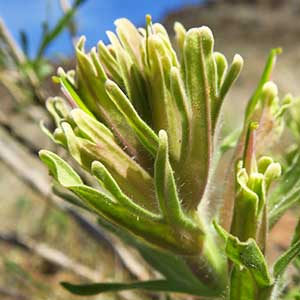Castilleja xanthotricha
Castilleja aquariensis
John Day or yellow-hairy paintbrush, John Day paintbrush, yellow hair paintbrush, yellow-hair Indian paintbrush
Aquarius paintbrush, Aquarius Plateau Indian paintbrush, Aquarius Plateau paintbrush
few to several, ± decumbent to erect or ascending, unbranched, sometimes with short, leafy axillary shoots, hairs erect to spreading, long, soft, eglandular, mixed with short stipitate-glandular ones.
few to several, ascending to erect, unbranched, hairs moderately dense, often retrorse, short, ± stiff, stipitate-glandular distally only in inflorescence.
green, linear, lanceolate to broadly lanceolate, oblong, or cuneate, 0.8–5 cm, not fleshy, margins plane to wavy, involute, 0–5-lobed, apex acute, sometimes rounded;
lobes spreading, linear, arising below mid length, nearly as broad as center lobe, apex acute.
appressed-ascending, green to purplish, linear to narrowly lanceolate, distal sometimes broadly lanceolate, (1–)2.5–4(–5.5) cm, not fleshy, margins plane, involute, 0(–5)-lobed, apex rounded to acuminate;
lobes ascending, linear to narrowly lanceolate, apex acute.
3–14 × 1.5–4.5 cm;
bracts proximally greenish, rarely dull reddish purple, distally white to cream, rarely pale yellow or dull, pale pink (sharply differentiated from proximal coloration), lanceolate or oblong to narrowly ovate, (3–)5–7-lobed;
lobes ascending, linear to obovate, ± broadened distally, medium, long, proximal lobes arising below mid length, central lobe apex broadly rounded to truncate, others acute to rounded.
2–7 × 1.5–2 cm;
bracts proximally pale green to pale yellow-green, distally pale to bright yellow or cream, rarely pale orange, elliptic, narrowly ovate, elliptic-oblong, broadly lanceolate, or ovate, (0–)3(–5)-lobed;
lobes ascending or spreading, narrowly lanceolate, short, arising near tip on distal bracts, central lobe apex rounded to truncate, lateral ones acute to rounded.
curved, 17–23 mm;
tube 15–19 mm;
beak exserted, adaxially green, 5–8(–9) mm, puberulent, stipitate-glandular;
abaxial lip deep purple (color sometimes visible through calyx), green, pinkish, or pale yellow, ± prominent, slightly inflated, usually hidden in calyx, sometimes right at top of calyx, 2 mm, ca. 50% as long as beak;
teeth ascending, whitish, yellowish, pink, or green, 1–1.5 mm.
straight, 17–25 mm;
tube 9–13 mm;
beak exserted, adaxially green, 6–8(–12) mm, margins red or reddish brown, short-hairy;
abaxial lip green, reduced, sometimes exserted, 1.5–2 mm, 10–15% as long as beak, glabrous;
teeth erect, green, 0.5–1.5 mm.
colored as bracts, 15–26 mm;
abaxial and adaxial clefts 3.5–7 mm, 25–50% of calyx length, deeper than laterals, lateral 2–5 mm, 12–25% of calyx length;
lobes linear, oblong, or narrowly triangular, center lobe apex usually rounded, lobes acute to rounded.
proximally green to yellowish, distal 1/2 yellow, (16–)18–25 mm;
abaxial and adaxial clefts (8–)9.5–12.5 mm, 50% of calyx length, deeper than laterals, lateral 0.5–5(–6) mm, 5–20% of calyx length;
lobes lanceolate to ovate, apex acute to obtuse.
= 48.
Castilleja xanthotricha
Castilleja aquariensis
Castilleja xanthotricha is endemic to moderate elevations in the sagebrush hills of the John Day River drainage in north-central Oregon. N. H. Holmgren (1971) hypothesized that this tetraploid species is of allopolyploid hybrid origin between C. glandulifera and C. oresbia.
(Discussion copyrighted by Flora of North America; reprinted with permission.)
Castilleja aquariensis is endemic to the Aquarius Plateau in the mountains of south-central Utah. Its meadow habitats were severely degraded by livestock grazing, and at one time the species was a candidate for listing under the Endangered Species Act of the United States. It is still a species of management concern.
Castilleja aquariensis is in the Center for Plant Conservation’s National Collection of Endangered Plants.
(Discussion copyrighted by Flora of North America; reprinted with permission.)
